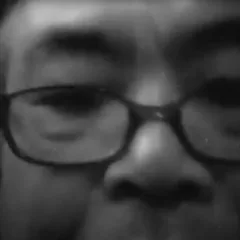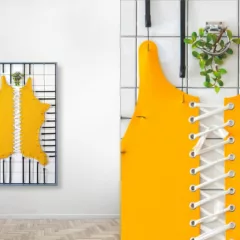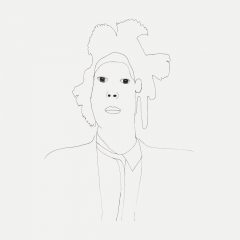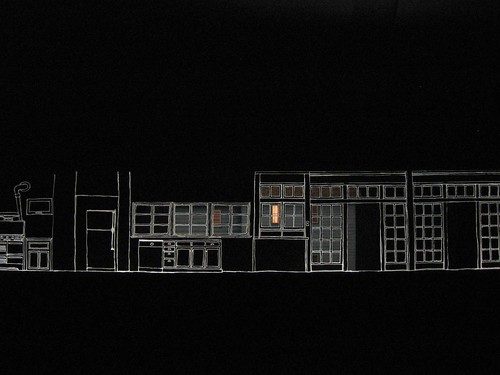
Darkness is my pillow at Vox Populi this month. Almost everything is noir, and the American Dream has turned into something lost, exploded, longed for and gone. At least that’s what I got over almost everything I saw there.
The most ambitious work on the subject is James Johnson‘s photo installation, Some Rooms-Part I (Yours). Corey Antis‘ smallish formalist paintings also refer to spaces and memory and feelings; and the video by Deborah Stratman at Screening Gallery, just inside Vox, also refers to these ideas. (Sarah Zwerling‘s Window, in the video lounge, wasn’t working when I was there).

James Johnson, Some Rooms-Part I (Yours)–the black picture window, showing a reflection of the gallery and a landscape drawing of a kitchen inside
Johnson, whose emotionally suggestive peephole views have grown this time to a dark, picture-window view. The cardboard corrugated boxes that held the little views have given way to a room-sized box. And the illusion of architectural space within the box has been simultaneously undercut and created by adding a scrim of architectural drawing in front of the more realistic photographic view.
This is Americana–about the vernacular architecture of the suburban landscape and how we are blocked from really entering other people’s lives and homes at the same time that we imbue them with our imaginations. It’s Robert Bechtle‘s cars as houses, or Henry Wessel‘s deadpan photos that reference real estate portraits.
In Johnson’s installation, the viewer looks through a dark, reflective picture window and through a blue-print-like, unbelievably long kitchen wall of counters, cabinets and windows. Beyond these layers stands a white clapboard house–a suburban classic–shrouded in darkness. Its windows light up and dim, inviting us to pick out the murky outlines of the house.
I yearned to look inside those lit windows as I stood there.

James Johnson, Some Rooms-Part I (Yours), infrastructure behind the installation is on display
Johnson makes sure you know it’s all faux. He leaves open the real gallery room behind the window for you to look at. It’s filled with the architectural infrastructure of the installation–a smaller box behind a bigger box, and a colorful mare’s nest of wires and a computer.
Even with this transparency, he still succeeds with the illusion–the yearning for all that the two houses–the barely visible one behind and the sketched one in front–represent. The layers of the drawn kitchen and the life-sized but reflective picture window add a distancing that cuts some of the emotional connection. The intimacy of the peephole and the revealed interior with light pouring in from behind has been lost. But layers of ideas and realities have filled the void. All in all, pretty great.
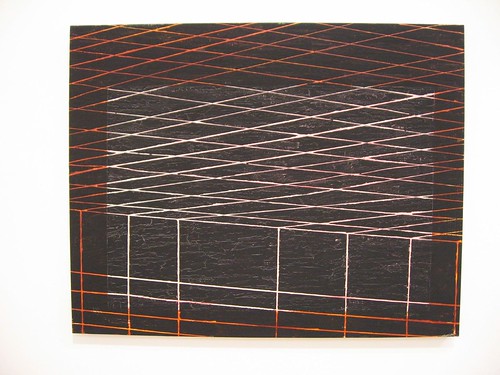
Corey Antis, Untitled Still (Black Room), 23 x 29 inches, acrylic, flashe on panel
Corey Antis was holding down the front desk at Vox when I arrived. He, too has a show there, and he said that in his own paintings, he is trying to capture the meaning and feeling of architectural spaces with a minimum of means and a consciousness of the materials he is using. In looking at these paintings, I also see the nostalgic vocabulary of interference on a television screen and the out-of-synch scratchiness of an old movie.

Palindrome, 24 x 29 inches, acrylic, flashe on panel
I’m interested in his tie to the brush stroke, which is most effective when it becomes something the painting is about–as in, Palindrome, and Untitled (black room), which become movie stills in a noir narrative that I can imagine my way into.
When the pieces work, the architectural vocabulary becomes a sort of Malevich block of paint, almost scrubbed away until it acquires a ghostliness and spiritual representation of memory, with only the textures and brush strokes pulling the work back to the concrete world.
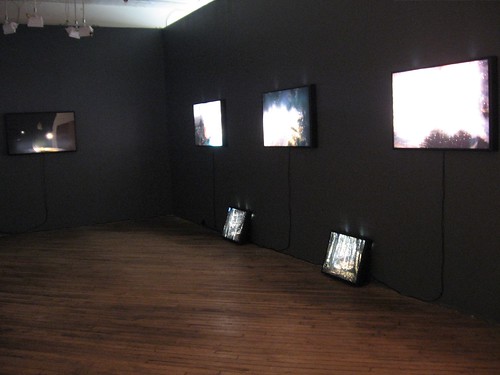
Julianna Foster’s installation, In A Vale, her first one-person exhibit at Vox
Also at Vox, Julianna Foster’s installation, In a Vale. The grouping of light-box-illuminated color transparencies recall horror and disaster movies and the weirdness that can transform the vernacular American landscape into a danger zone. I liked the individual images a lot; they are pure photographic fiction from the Hollywood conventions–stuck on a deserted road, lost in the woods, beset by fog, etc., etc. The installation, which suggests a series of related movie stills, undercuts the narratives of the individual images and does them a disservice, overall, I think. But the use of the light boxes with cinema-inspired stills feels just right.
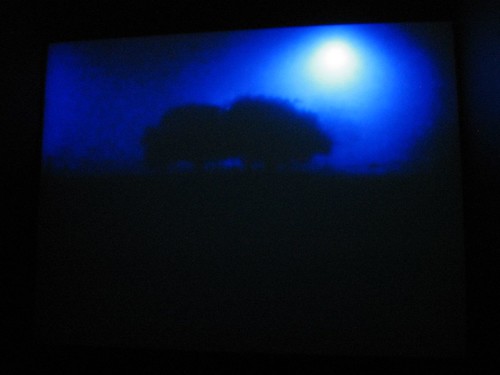
The moon is ghostly in this night-time shot from Deborah Stratman’s video In Order Not to be Here.
Which brings me to Screening Gallery, the video gallery within Vox. Deborah Stratman’s 33-minute video In Order Not to be Here is about surveillance in our daily worlds. In the video, shot totally at night, we see guards in front of a wall of tv monitors and a guard dog baring its teeth materializes in the night light. We see empty parking lots and unpopulated cul de sacs. This is all quite unsettling, with its suggestion of an embattled nation living in fear and putting up with an utter loss of privacy at the same time that the nation is pulling up the drawbridges of life to hide in mcmansions in the ‘burbs. This video makes its points by showing the familiar as the sinister–mixed with beauty. Although there’s no narrative, the emotional and political punch are pretty great (warning–it may totally depress you).
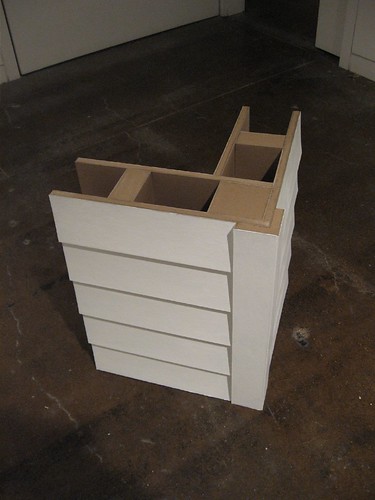
Leah Bailis, Corner, cardboard and paint, 2007, at Fleisher/Ollman
In the same vein, I want to mention Vox member Leah Bailis’ piece that’s now up in 2000 Years of Sculpture at Fleisher/Ollman. Her sculpture is a fragment of the sort of white clapboard American Dream house that’s in James Johnson’s piece. Bailis, too, shows us infrastructure–of the walls–the American Dream laid bare and dissected as a flimsy facade.
In the work of all these artists, I was particularly conscious of how they were feeling the national loss of innocence and the yearning for safer, more optimistic times.

Justin Schiedel, So Long (Philly), video
On a lighter note, also at Vox, So Long (Philly), by Canadian artist Jason Schiedel, depicts a manic flight of a barely visible figure moving through urban scenes–from all the cities where the video has shown, so it gets longer as its exhibition history grows. It’s hilarious and tornado-like–the only truly upbeat art in the lot. Even the tilt of the overturned tv doesn’t suggest threat, but rather wild exuberance.


